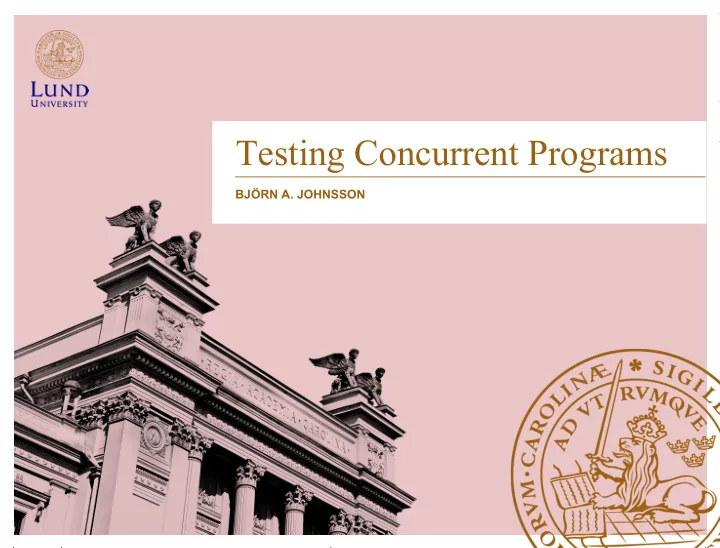

Testing Concurrent Programs BJÖRN A. JOHNSSON
Introduction • Concurrency introduces degree of non-determinism • Similar techniques/patterns, larger space of errors • Errors are rare probabalistic occurences, not deterministic ones. • Tests: for safety , or liveness • Chapter overview – Testing for correctness – (Testing for performance) – (Pitfalls, performance testing) – (Complementary testing approaches)
Testing for correctness @ThreadSafe availableItems.release(); public class BoundedBuffer<E> { } private final Semaphore availableItems, availableSpaces; public E take() throws InterruptedException { @GuardedBy("this") private final E[] items; availableItems.acquire(); @GuardedBy("this") private int putPosition = 0, E item = doExtract(); takePosition = 0; availableSpaces.release(); return item; public BoundedBuffer(int capacity) { } availableItems = new Semaphore(0); private synchronized void doInsert(E x) { availableSpaces = new Semaphore(capacity); int i = putPosition; items = (E[]) new Object[capacity]; items[i] = x; } putPosition = (++i == items.length)? 0 : i; public boolean isEmpty() { } return availableItems.availablePermits() == 0; private synchronized E doExtract() { } int i = takePosition; public boolean isFull() { E x = items[i]; return availableSpaces.availablePermits() == 0; items[i] = null; } takePosition = (++i == items.length)? 0 : i; public void put(E x) throws InterruptedException { return x; availableSpaces.acquire(); } doInsert(x); }
TESTING FOR CORRECTNESS Basic unit tests • Start simple (non-concurrent)! • Include sequential test • Excludes problems not related concurrency class BoundedBufferTest extends TestCase { void testIsEmptyWhenConstructed() { BoundedBuffer<Integer> bb = new BoundedBuffer<Integer>(10); assertTrue(bb.isEmpty()); assertFalse(bb.isFull()); } void testIsFullAfterPuts() throws InterruptedException { BoundedBuffer<Integer> bb = new BoundedBuffer<Integer>(10); for (int i = 0; i < 10; i++) bb.put(i); assertTrue(bb.isFull()); assertFalse(bb.isEmpty()); } }
TESTING FOR CORRECTNESS Testing blocking operations void testTakeBlocksWhenEmpty() { • Lacking support in most testing final BoundedBuffer<Integer> bb = new frameworks BoundedBuffer<Integer>(10); – Helper threads – which test failed? Thread taker = new Thread() { public void run() { • Success if thread does not proceed try { int unused = bb.take(); fail(); // if we get here, it’s an error • Unblock via interruption } catch (InterruptedException success) { } }}; – Requires interruption responsiveness try { taker.start(); • How long to wait? Slow or blocked? Thread. sleep(LOCKUP_DETECT_TIMEOUT); taker.interrupt(); taker.join(LOCKUP_DETECT_TIMEOUT); assertFalse(taker.isAlive()); • Don’t use Thread.getState 1 ! } catch (Exception unexpected) { fail(); } } 1 1 Exercise!
TESTING FOR CORRECTNESS Testing safety • Test for data races – Multiple threads doing put and take for how long – Test nothing went wrong • ”Chicken-and-egg” problem … • For classes used in producer-consumer – Everything put into queue comes out, and nothing else – Naïve: ”shadow” list – distorts scheduling due to syncronization and blocking – Better: Use checksums for enqueued items » Don’t use compiler guessable checksums!
TESTING FOR CORRECTNESS Testing safety (cont’d) public class PutTakeTest { } private static final ExecutorService pool = void test() { Executors.newCachedThreadPool(); try { for (int i = 0; i < nPairs; i++) { private final AtomicInteger putSum = new AtomicInteger(0); pool.execute(new Producer()); private final AtomicInteger takeSum = new pool.execute(new Consumer()); AtomicInteger(0); } barrier.await(); // wait for all threads to be ready private final CyclicBarrier barrier; barrier.await(); // wait for all threads to finish private final BoundedBuffer<Integer> bb; assertEquals(putSum.get(), takeSum.get()); private final int nTrials, nPairs; } catch (Exception e) { throw new RuntimeException(e); public static void main(String[] args) { } new PutTakeTest(10, 10, 100000).test(); } pool.shutdown(); class Producer implements Runnable { /* next slide */ } } class Consumer implements Runnable { /* next slide */ } PutTakeTest(int capacity, int npairs, int ntrials) { } this.bb = new BoundedBuffer<Integer>(capacity); this.nTrials = ntrials; this.nPairs = npairs; this.barrier = new CyclicBarrier(npairs * 2 + 1);
TESTING FOR CORRECTNESS Testing safety (cont’d) class Producer implements Runnable { class Consumer implements Runnable { public void run() { public void run() { try { try { int seed = (this.hashCode() ^ (int)System. nanoTime()); barrier.await(); int sum = 0; int sum = 0; barrier.await(); for (int i = nTrials; i > 0; --i) { for (int i = nTrials; i > 0; --i) { sum += bb.take(); bb.put(seed); } sum += seed; takeSum.getAndAdd(sum); seed = xorShift(seed); barrier.await(); } } catch (Exception e) { putSum.getAndAdd(sum); throw new RuntimeException(e); barrier.await(); } } catch (Exception e) { } throw new RuntimeException(e); } } } }
TESTING FOR CORRECTNESS Testing resource management • Test e.g. r esource leaks – Objects that hold other objects should not hold them when unnecessary • Important for bounded classes – The point is to not have uncontrollably growing objects (needs tests) class Big { double[] data = new double[100000]; } void testLeak() throws InterruptedException { BoundedBuffer<Big> bb = new BoundedBuffer<Big>(CAPACITY); int heapSize1 = /* snapshot heap, “forces” GC */; for (int i = 0; i < CAPACITY; i++) bb.put(new Big()); for (int i = 0; i < CAPACITY; i++) bb.take(); int heapSize2 = /* snapshot heap, “forces” GC */; assertTrue(Math.abs(heapSize1-heapSize2) < THRESHOLD); }
TESTING FOR CORRECTNESS More tricks for interleavings • Number of threads > number of CPUs • Test on various systems with different: – Number of CPUs, processor clock frequencies, operating systems, processor architectures, … • Use Thread.yield – more context switches – Code ”messiness” could be fixed with AOP public synchronized void transferCredits(Account from, Account to, int amount) { from.setBalance(from.getBalance() - amount); if (random.nextInt(1000) > THRESHOLD) Thread. yield(); to.setBalance(to.getBalance() + amount); }
Summary • Testing correctness in concurrent programs is challenging – Low-probability failure modes – Sensitive to timing, load, and other hard-to-reproduce conditions • Risk of tests introducing additional synchronization and timing constraints – Might ”hide” concurrency problems being tested
Recommend
More recommend